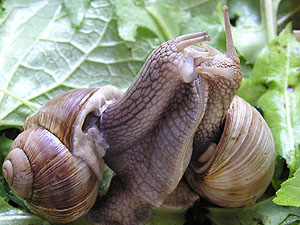Reproduction

©Nordsieck,
R. (2009) Beginning of snail mating process.
Gastrocopta procera is a hermaphroditic organism; meaning it has both male and female reproductive organs. G. procera, along with many other land snails are hermaphrodites because of their slow movement. The chance of meeting a partner of the opposite sex is extremely low because of how slow the snail’s movement is so, it would be impractical to have snails of the opposite sex. The genus Gastrocopta mates by holding reserves of sperm and eggs for when they meet another snail of their same species. When they meet another snail, both raise up their heads, place their muscular feet together, and eject sperm into an oviduct or a pouch which holds the gametes. During copulation, the snails touch their tentacles together and move their feet against each other in wave-live movements (Nordsieck, R). Gastrocopta lay eggs after fertilization in deep, moist leaf litter or underneath logs where eggs remain moist for proper development. Self-fertilization can occur but it is normal for Gastrocopta to mate with another snail. Snails mate in moist areas because they must be in moist environments to survive and for their eggs to survive (Laws).